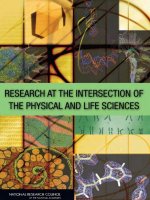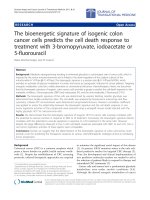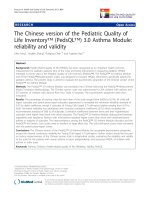5 3 the building blocks of organisms (life sciences)
Bạn đang xem bản rút gọn của tài liệu. Xem và tải ngay bản đầy đủ của tài liệu tại đây (5.15 MB, 12 trang )
Life Sciences
Standards
Preview
2.e. Students know how sugar, water,
and minerals are transported in a
vascular plant.
Standard Set 2. Life Sciences
2. Plants and animals have structures for
respiration, digestion, waste disposal,
and transport of materials. As a basis
for understanding this concept:
2.f. Students know plants use carbon
dioxide (CO2) and energy from sunlight
to build molecules of sugar and release
oxygen.
2.a. Students know many multicellular
organisms have specialized structures
to support the transport of materials.
2.g. Students know plant and animal
cells break down sugar to obtain
energy, a process resulting in carbon
dioxide (CO2) and water (respiration).
by Lillian Duggan
Genre
Comprehension Skill
Nonfiction
Make Generalizations
Text Features
•
•
•
•
Captions
Diagrams
Labels
Glossary
Science Content
Structures of
Living Things
Scott Foresman Science 5.3
ISBN 0-328-23570-9
ì<(sk$m)=cdfhae< +^-Ä-U-Ä-U
Vocabulary
cellular respiration
chlorophyll
chloroplast
organ
phloem
photosynthesis
tissue
vacuole
vascular
xylem
by Lillian Duggan
Picture Credits
Every effort has been made to secure permission and provide appropriate credit for photographic material. The
publisher deeply regrets any omission and pledges to correct errors called to its attention in subsequent editions.
Unless otherwise acknowledged, all photographs are the copyright of Dorling Kindersley, a division of Pearson.
Photo locators denoted as follows: Top (T), Center (C), Bottom (B), Left (L), Right (R), Background (Bkgd).
1 Ken Wagner/Visuals Unlimited; 3 (Inset) David Bassett/Photo Researchers, Inc., (Bkgd) Dr. Neal Scolding/Photo
Researchers, Inc.; 14 Michael Gadomski/Animals Animals/Earth Scenes; 15 (T) Biodisc/Visuals Unlimited, (B) Ken
Wagner/Visuals Unlimited; 19 Michael Bisceglie/Animals Animals/Earth Scenes.
ISBN: 0-328-23570-9
Copyright © Pearson Education, Inc. All Rights Reserved. Printed in the United States of America.
This publication is protected by Copyright, and permission should be obtained from the publisher prior to any
prohibited reproduction, storage in a retrieval system, or transmission in any form by any means, electronic,
mechanical, photocopying, recording, or likewise. For information regarding permission(s), write to
Permissions Department, Scott Foresman, 1900 East Lake Avenue, Glenview, Illinois 60025.
1 2 3 4 5 6 7 8 9 10 V010 13 12 11 10 09 08 07 06
What are multicellular
organisms made of?
Plants and animals are made up of cells. Cells are living parts
that have the same needs as the plants and animals they make
up. The smaller parts inside cells carry out specialized jobs so
that cells can meet their needs.
The Jobs of Cells
The basic building blocks of all living things are cells. Cells
are the tiniest living parts of plants and animals. Some living
things are made up of only one cell. Multicellular organisms can
be made up of trillions of cells.
Cells are extremely small. You have to look through a
microscope to see most cells. One drop of blood has millions
of red blood cells.
Like all living things, cells have basic needs for survival.
They take in food to use for growth and to repair broken parts.
They also release wastes. Like you, cells sense changes in their
environment and respond to these changes. Most cells do
not move, but all cells have parts that move. They can even
communicate and work with other cells to get jobs done.
Cells also need energy to grow, move, and make new cells.
To get energy, most cells use cellular respiration. In cellular
respiration, oxygen and food are combined to get energy.
These are brain cells called
neurons. Trillions of neurons
work together to help your
body to function.
2
3
Cell Parts
Cell Size and Shape
There are many different types of cells, but all cells have
some parts in common. Some cell parts perform the same jobs as
the structures of your body. For example, some cell parts form a
protective covering, just like your skin. Other cell parts control what
happens in the cell, provide support, and store food and wastes.
The diagram below shows the parts of an animal cell. The
cell membrane goes around the outside of the cell. It holds the
cell together and controls what materials go in and out. Sugar,
water, and oxygen are allowed to enter the cell. The vacuole
stores water and nutrients. It may also help the cell digest food.
Wastes such as carbon dioxide leave the cell.
Plant cells contain all of the parts that animal cells have.
They also have chloroplasts and cell walls, which animal cells
do not have.
All cells must stay a certain size. If a cell grows too big,
important materials such as oxygen won’t be able to reach all
the parts of the cell fast enough to keep the cell alive. On the
other hand, if a cell is too small, it can’t contain all of its parts.
The shape of cells is also important. Some cells have special
shapes that fit the job they do. Many cells even have special
structures that help them to do their work.
Plant Cell
Vacuole
stores water
and nutrients
Cell wall
gives the cell
extra support
Mitochondria
change chemical energy
of food into a form that
the cell can use
Nucleus
directs the cell’s
activities and
stores information
Ribosome
begins the process
of making proteins
Cell membrane
Chloroplast and chlorophyll
Chloroplasts contain chlorophyll,
allowing the plant to make food.
Cytoplasm
fluid containing
cell parts
Animal Cell
4
5
From Cells to Tissues
From Organs to Organ Systems
Cells usually do not do their jobs alone. Instead, they work
with other cells in tissues. A tissue is a group of the same kind
of cells that work together to do the same job. Bundles of nerve
cells make up nerve tissue, just like bundles of muscle cells make
up muscle tissue. Skin is a tissue made up of a group of skin cells.
Plants have tissues too.
Just as cells and tissues work together, so do organs. An
organ system is a group of organs that work together to carry
out a life process. Organ systems are important to living things.
For example, the nerves, spinal cord, and brain work together
to process information. Blood cells, blood vessels, and the heart
form the circulatory system. Look below to see how tissues and
organs compare between a human and a plant.
From Tissues to Organs
Different types of tissues combine to form organs. An
organ is a group of different tissues that join together into one
structure. Organs such as your heart, lungs, ears, and kidneys
perform important jobs in your body. Many animals have similar
tissues and organs. Plants also have organs, including stems,
roots, leaves, and flowers.
These pictures show a
heart muscle cell, heart
muscle tissue, the heart
organ, and the circulatory
system in a person.
Cell
Tissue
Organ
System
Here we see a cell, tissue,
leaves, and the entire
California oak tree.
6
7
Getting Food and Oxygen
Transporting Nutrients and Wastes
In order to stay alive, cells must be able to get food and
oxygen, and get rid of wastes. Multicellular organisms use
different organ systems to carry out these tasks.
Look at the picture of the digestive system of a rabbit. The
job of the digestive system is to take in food and break it down
into a form that body cells can use. The substances in food that
cells take in are called nutrients.
Nutrients can only be used by cells if they are transported
to the cells. This job is done by the blood. Blood is a tissue in
the circulatory system. It also carries sugar and oxygen to cells.
Another role of blood is to carry wastes away from cells.
Look at the picture of the circulatory system of a fish. The
heart and blood vessels are organs in the fish’s circulatory
system. The gills are part of the respiratory system. The fish
absorbs oxygen through its gills. Then the oxygen is carried by
the blood to all of the fish’s cells. The blood also picks up wastes
made by the cells. One waste is carbon dioxide. It is carried
to the gills, which let it out. Other waste is removed by the
excretory system.
This picture shows the
organs in the rabbit’s
digestive system.
The circulatory system
of a fish supplies food
and oxygen to all of
the fish’s cells.
Mouth
Large
intestine
Esophagus
Stomach
Small
intestine
8
9
How do materials
move through plants?
Two of the major organs of plants are stems and roots. Their
special structures allow them to perform important jobs.
Stems and Leaves
Stems are plant organs that support,
or hold, other plant organs. These organs
include leaves, fruit, and flowers. Leaves
take in sunlight to make food. Some stems
hold leaves high so that they can receive
more sunlight. Leaves held lower to the
ground might be more shaded.
The Vascular System
Like animals, plants need a system
to transport materials. Many plants use
a vascular system. A vascular system
is a system of tubes that transport
materials such as water and minerals.
Plants that use a vascular system are
called vascular plants. The roots, stems, and
leaves of vascular plants contain vascular tissue
called xylem and phloem.
10
Xylem tubes carry materials from the plant’s roots to its
leaves. Plant roots soak up water from the soil. The water
contains minerals that plants need. These minerals are important
for plant processes such as photosynthesis.
Phloem tubes carry sugar away from the leaves. The sugar
is dissolved in water and gets carried by the phloem to the roots.
Phloem in trees is located under the bark. The growth of
new phloem cells causes the old, dead phloem cells to be pushed
outward. The old phloem makes up the bark, which protects the
new phloem.
Cross-section of a
woody stem
Xylem
Cross-section of a
non-woody stem
Phloem
Trees and shrubs have
woody stems. Woody
stems have a lot more
xylem tissue than
non-woody stems.
Plants such as sunflowers
and pea plants (left) have
non-woody stems. They
have less xylem tissue.
11
More About Vascular Plants
As you know, many plants have a vascular system for
transporting materials. To get the energy they need, plants break
down sugar. This sugar is what plants use for food. Plants make
this food in their leaves. Once the sugar is broken down, it is
transported from the leaves to the rest of the plant. Remember
the phloem? This system of tubes is what transports the sugar all
over the plant.
Plants use water to make food. The roots of a plant get water
by absorbing it from the soil. Then the water and dissolved
minerals travel from the soil to the rest of the plant through
the xylem.
You can see the vascular system at work in a simple
experiment. If you’ve eaten celery, you’ve eaten a stem. A leaf
stem attaches a plant’s leaves to its stem. Celery is a stem that
can show how xylem works. In this experiment, a stalk of celery
is placed in a cup containing water mixed with food coloring.
The food coloring represents minerals dissolved in the water.
While the celery sits, water evaporates from its leaves. Then
the colored water from the cup begins to move up the stalk to
replace the evaporated water.
The picture of the soaked celery shows that the red food
coloring moved up the stalk through the xylem. You can see
a single xylem cell from a cross-section of the celery under
a microscope.
This is a microscopic view
of a single xylem cell.
As the colored water moves up
the leaf stem, you can see it turn
the xylem cells red.
12
13
Types of Roots
Root Functions
Like stems, roots are a type of plant organ. Roots grow
underground, holding the plant firmly in the ground as it grows.
There are different kinds of root systems. Two of the main
types are taproots and fibrous roots. A taproot is a large root
that grows straight down into the ground. Small roots may grow
from the main taproot. But the taproot will remain the largest
root structure as the plant grows. Carrots, beets, turnips, and
radishes are all taproots.
Fibrous root systems have many roots growing in all
directions. Fibrous roots are much thinner than taproots, and
they divide into smaller and smaller roots. They look like an
upside-down version of the branches on a tree.
Roots have special tissues near their tips that help them to
grow longer. The cells that make up these tissues divide quickly,
forming new cells. The new cells push the
root tips farther into the ground as
they grow.
Roots have several important jobs. Some roots store food.
Roots also anchor a plant in the soil and absorb water from
the soil. Nutrients dissolved in water help the plant grow, stay
healthy, and reproduce.
This is the fibrous root
system of a cosmos.
14
Xylem and phloem cells form tubes in the
cross-section of this soybean root.
Soybean roots
15
How Cells Get and
Use Energy
A plant’s leaves make sugar. This sugar contains energy the
plant can use for life functions. Cells break down the sugar to
release its energy.
Making Sugar
Plant leaves contain chlorophyll.
Chlorophyll is a green substance that
traps energy from the Sun and allows
plants to make their own food.
Plant cells contain structures called
chloroplasts. Chloroplasts store
chlorophyll. Animal cells do not have
chloroplasts or chlorophyll. They cannot
make their own food.
Plants make a sugar, glucose, in a
process called photosynthesis. During
photosynthesis, a plant uses water, light
energy from the Sun, and carbon dioxide
from the air. When the carbon dioxide
and water are combined, the plant makes
sugar and oxygen. Sugar is a source of
energy for the plant and for organisms
that eat the plant.
A thin layer of cells on
the top and bottom of
the leaf allows sunlight
to pass into the middle
of the leaf.
This chloroplast contains
chlorophyll. Inside the chloroplast
is a large light-colored structure.
This structure holds starch, which
was made from sugar.
16
Chlorophyll must be present for photosynthesis to take
place. The following equation represents the process of
photosynthesis:
6CO2 + 6H2O
carbon dioxide + water
light energy
chlorophyll
C6H12O6 + 6O2
sugar + oxygen
During photosynthesis, plants take in carbon dioxide and
release oxygen. Without the oxygen made by plants, most
organisms would not be able to survive.
Some leaves have waxy coverings
to help prevent water loss.
Tall, thin cells in the
middle of the leaf contain
chloroplasts. They
absorb sunlight, so that
photosynthesis can take
place.
This is the vein of a leaf. The
xylem and phloem are found
here.
Because these cells are spread
apart, carbon dioxide can move
easily through the leaf.
Most leaves exchange water
vapor, carbon dioxide,
and oxygen through tiny
openings on the bottom.
The leaf bottom is protected
from the Sun, so it is cooler
than the top. Therefore, less
water is lost.
17
Getting Energy from Food
The Carbon Dioxide-Oxygen Cycle
Sometimes plants make more sugar than they need. Any
extra sugar is stored in the plant as other kinds of sugars or
starches. When the plant needs more energy, it must break
down this extra food to release the energy.
The process by which cells break down sugar to release
energy is called cellular respiration. Respiration is a word
people may use to mean breathing air through the lungs. But
cellular respiration is different from breathing.
During cellular respiration, sugar starts to be broken down
in the mitochondria. The result is the creation of carbon dioxide
and water, and the release of energy. The following equation
shows the process of cellular respiration:
You may have noticed that the equations for photosynthesis
and cellular respiration are very similar. They look like the
reverse of each other. The sugar and oxygen that are made
during photosynthesis are combined during cellular respiration.
The two processes form a cycle. The cycle is called the carbon
dioxide-oxygen cycle.
The carbon dioxide-oxygen cycle involves both plants and
animals. Plants take in oxygen and carbon dioxide through their
leaves. Animals breathe in oxygen from the air. Both plants and
animals use oxygen during respiration to make energy from
food. Their cells release carbon dioxide. In animals, the released
carbon dioxide enters the blood and is transported to the lungs.
Plants use energy to change water and carbon dioxide into more
food and oxygen during photosynthesis. The carbon dioxideoxygen cycle helps living things get the oxygen and carbon
dioxide they need to live.
C6H12O6 + 6O2
Sugar + oxygen
Oxygen
6CO2 + 6H2O + Energy
carbon dioxide + water + energy
Carbon dioxide
Energy
Carb
on Dioxid
e
The carbon dioxide-oxygen
cycle makes sure that plants
and animals have the oxygen
and carbon dioxide they need.
Sugar
Water
Oxygen
18
19
Glossary
cellular respiration
the process by which cells break down
sugar to release energy, water, and
carbon dioxide
chlorophyll
a green substance that allows plants to
make their own food
chloroplast
structures in plant cells that store
chlorophyll
organ
a group of different tissues that join
together to form one structure
phloem
tubes that carry sugar away from a
plant’s leaves to the rest of the plant
photosynthesis
the process by which plants use carbon
dioxide and energy from sunlight to
produce oxygen and sugar
tissue
a group of the same kind of cells that
work together to do a job
vacuole
a part of a cell that stores water and
nutrients
vascular
describes the system of tubes in certain
plants that transports water and minerals
xylem
tubes that carry water and minerals from
a plant’s roots to its leaves
20
What did you learn?
1. What parts do plant cells have that are not found in animal cells?
2. Name two plants that have taproots.
3. What system in plants do xylem and phloem belong to?
4.
You learned that cells have structures that
carry out life functions. Write a paragraph that compares a vacuole
and a mitochondrion. Consider their jobs and their locations in the
cell. Include a topic sentence and simple supporting facts and
details.
5.
Make Generalizations What generalizations can you make
about how organisms transport nutrients?









